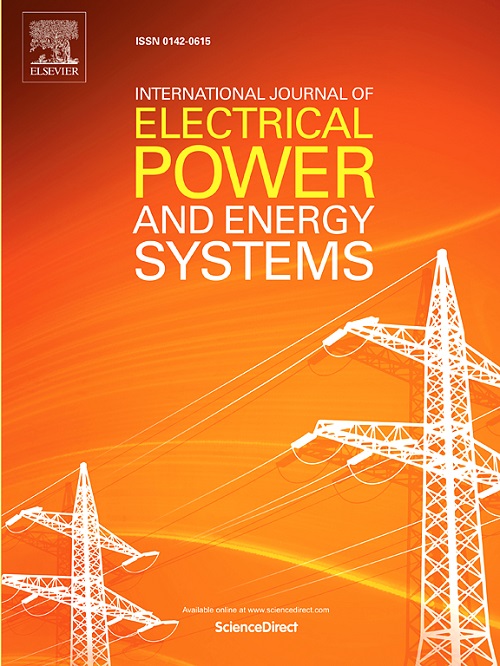Research on frequency modulation of thermal power units combined with compressed air energy storage based on model predictive control
IF 5
2区 工程技术
Q1 ENGINEERING, ELECTRICAL & ELECTRONIC
International Journal of Electrical Power & Energy Systems
Pub Date : 2025-04-10
DOI:10.1016/j.ijepes.2025.110646
引用次数: 0
Abstract
Amidst China’s pursuit of carbon peaking and neutrality targets, there is a pressing need to establish a novel power system that primarily relies on renewable energy sources (RES). To tackle the challenges this transition poses to the existing power grid, it is imperative to fortify the power system’s frequency modulation capabilities, which in turn calls for the exploration of diverse energy storage solutions. This research introduces, simulates, and evaluates an innovative charge–discharge control methodology designed to augment the frequency modulation capabilities of the thermal power unit (TPU) through the integration of the compressed air energy storage (CAES) system. Firstly, by considering the dynamic characteristics and operational mechanism, fundamental transfer function models for TPU and the CAES system are established; based these models, the frequency modulation model of a two-area power grid incorporating TPU and CAES is presented. Subsequently, a power adaptive allocation strategy is formulated with nonlinear signal decomposition techniques, enabling adaptive power distribution between TPUs and CAES. Furthermore, a control strategy utilizing model predictive control (MPC) is proposed, taking into account the state of charge (SOC) of CAES, to refine the energy charge and discharge process. The effectiveness is tested under two scenarios: step disturbance and continuous disturbance. Compared to TPU-only frequency modulation, the presented strategy achieves remarkable outcomes: a 21.9 % reduction in maximum frequency deviation following step disturbances, a 52.2 % decrease in steady-state frequency deviation, and a 37.5 % mitigation of TPU output power fluctuations under continuous disturbances. The results underscore the significant potential of the proposed strategy in alleviating the frequency modulation burden on TPUs, thereby contributing to their secure and stable operation within the evolving power system landscape.
基于模型预测控制的火电机组调频与压缩空气储能结合研究
在中国追求碳峰值和碳中和目标的过程中,迫切需要建立一个主要依赖可再生能源(RES)的新型电力系统。为了应对这种转变给现有电网带来的挑战,必须加强电力系统的调频能力,这反过来又要求探索多样化的储能解决方案。本研究介绍、模拟并评估了一种创新的充放电控制方法,该方法旨在通过集成压缩空气储能(CAES)系统来增强热电机组(TPU)的调频能力。首先,考虑TPU和CAES系统的动态特性和运行机理,建立了TPU和CAES系统的基本传递函数模型;在此基础上,提出了TPU与CAES相结合的两区电网调频模型。随后,利用非线性信号分解技术制定了功率自适应分配策略,实现了tpu与CAES之间的功率自适应分配。在此基础上,提出了一种考虑CAES充电状态(SOC)的模型预测控制(MPC)控制策略,以优化CAES的能量充放电过程。在阶跃干扰和连续干扰两种情况下测试了该方法的有效性。与仅TPU调频相比,所提出的策略取得了显著的效果:在阶跃干扰后最大频率偏差降低21.9%,稳态频率偏差降低52.2%,连续干扰下TPU输出功率波动降低37.5%。结果强调了所提出的策略在减轻tpu的调频负担方面的巨大潜力,从而有助于其在不断发展的电力系统环境中安全稳定地运行。
本文章由计算机程序翻译,如有差异,请以英文原文为准。
求助全文
约1分钟内获得全文
求助全文
来源期刊
CiteScore
12.10
自引率
17.30%
发文量
1022
审稿时长
51 days
期刊介绍:
The journal covers theoretical developments in electrical power and energy systems and their applications. The coverage embraces: generation and network planning; reliability; long and short term operation; expert systems; neural networks; object oriented systems; system control centres; database and information systems; stock and parameter estimation; system security and adequacy; network theory, modelling and computation; small and large system dynamics; dynamic model identification; on-line control including load and switching control; protection; distribution systems; energy economics; impact of non-conventional systems; and man-machine interfaces.
As well as original research papers, the journal publishes short contributions, book reviews and conference reports. All papers are peer-reviewed by at least two referees.

 求助内容:
求助内容: 应助结果提醒方式:
应助结果提醒方式:


